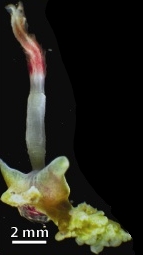Osedax
| Osedax | |
|---|---|
 |
|
| Osedax roseus | |
| Scientific classification | |
| Kingdom: | Animalia |
| Phylum: | Annelida |
| Class: | Polychaeta |
| Order: | Sabellida |
| Family: | Siboglinidae |
| Genus: |
Osedax Rouse et al., 2004 |
| Species | |
|
See text. |
|
See text.
Osedax is a genus of deep-sea siboglinid polychaetes, commonly called boneworms, zombie worms, or bone-eating worms. Osedax is Latin for "bone-eating". The name alludes to how the worms bore into the bones of whale carcasses to reach enclosed lipids, on which they rely for sustenance.
Scientists from the Monterey Bay Aquarium Research Institute using the submarine ROV Tiburon first discovered the genus in Monterey Bay, California, in February 2002. The worms were found living on the bones of a decaying gray whale in the Monterey Canyon, at a depth of 2,893 m (9,491 ft).
Lacking stomach and mouth, Osedax rely on symbiotic species of bacteria that aid in the digestion of whale proteins and lipids and release nutrients that the worms can absorb. Osedax have colorful feathery plumes that act as gills and unusual root-like structures that absorb nutrients. The Osedax secrete acid (rather than rely on teeth) to bore into bone to access the nutrients. Between 50 and 100 microscopic dwarf males live inside a single female and never develop past the larval stage.
Female Osedax worms have been observed spawning both in the wild and in laboratory aquaria (Rouse et al., 2009). Osedax rubiplumus can spawn hundreds of oocytes at a time. The worms' endosymbionts, species of bacteria in the order Oceanospirillales, were not observed in the spawned oocytes, which suggests that they are acquired after the worms settle on the bones. In the adult, the bacteria are localised in the root-like structures that grow into the whale bone. This worm appears to be highly fecund and reproduces continuously. This may help explain why Osedax is such a diverse genus, despite the rarity of whale falls in the ocean.
...
Wikipedia
